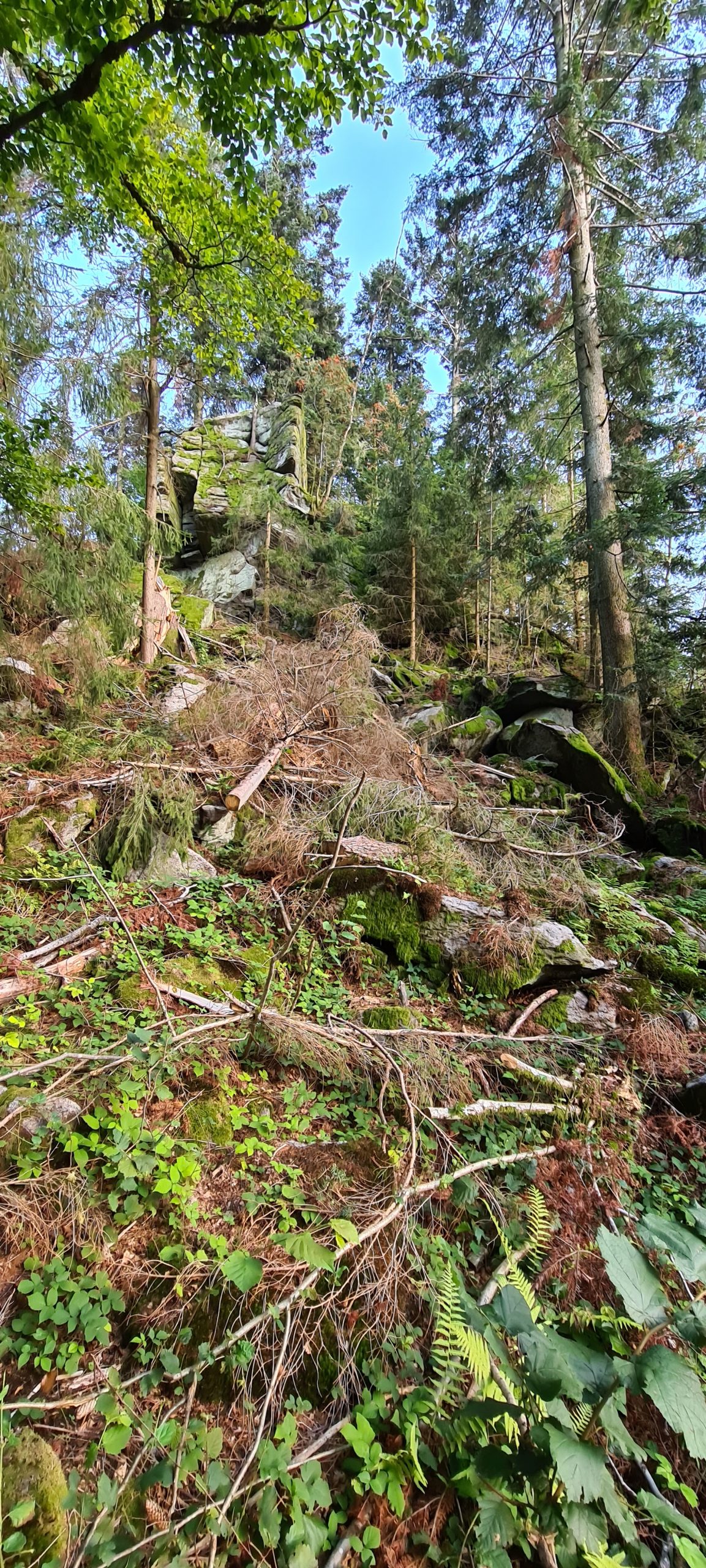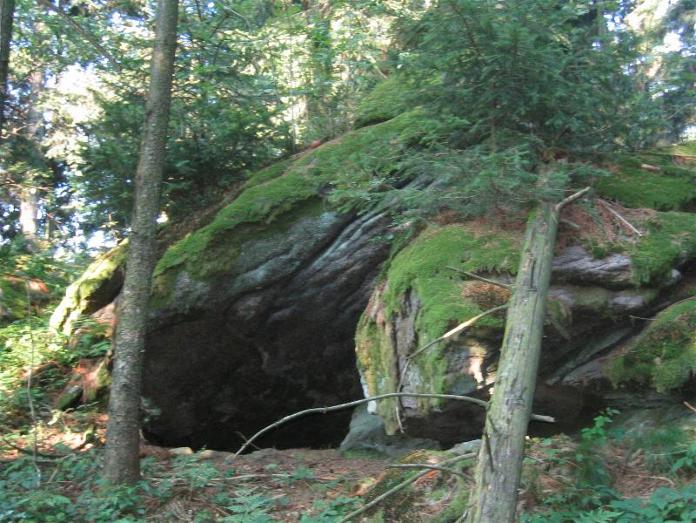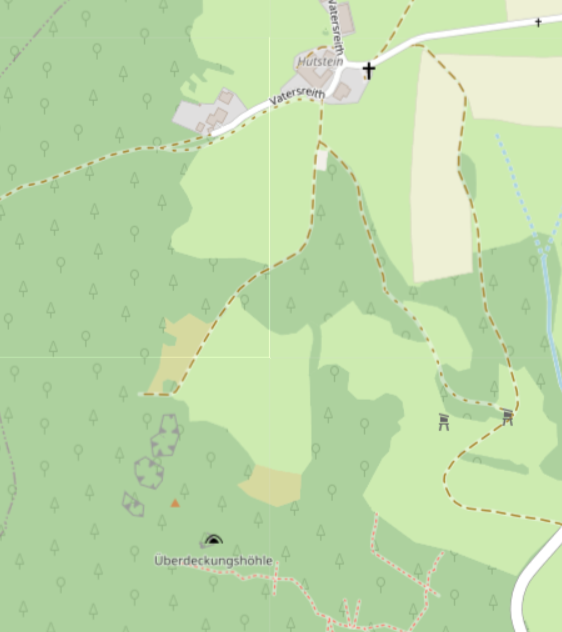




According to old legends this cave was home to a prophetess: a wise young lady living in it several hundreds of years ago.
Family Research





According to old legends this cave was home to a prophetess: a wise young lady living in it several hundreds of years ago.
Holzmännlein and Holzweiblein
When I first visited the ‘Hutstein’ I was told by an old lady sitting in front of her house in the hamlet of Hutstein that I should take care of the ‘Holzmännlein’ (‘Woidmanschgerl’) in the forest there, which she already met.
Male and female dwarfs, inhabitants of the forest, of whom there are countless, can still be found today, as the inhabitants of the area assure.
For example, a farmer once saw an ancient woman, barely half a meter tall, collecting spruce and pine cones in his huge humpback basket. Suddenly, however, she turned to the farmer and ordered him to carry the basket and follow him. But the peasants took fright, and he ran away as fast as he could.
The next morning, however, his hayfield was littered with thousands of cones, which he had to laboriously remove before he could dry and bring home his hay. It remained enigmatic how the little woman had scattered the countless baskets full of cones across the meadow. Certainly the whole little people of Grettenbergwald had helped him.
When I visited last time I was told that the cave at the Hutstein is still existing nowadays and that it was used not so long time ago, i.e. last century, by an elderly women who was said to live there and steal hens around this area.
Well known are the myths and legends around the Grettenberg hill – where the Hutstein rock is a part from – close to the villages of Oberkappel and Hutstein.

The Grettenberg
The fact that the Grettenbergwald near Oberkappel is not quite scary is something the kids already know, and how much more so are the elderly. A whole series of stories tells of strange things that have taken place there in the high, mighty mountain forest and even still carry on. The forest extends far over the ridge towards Kollerschlag and thus directly adjoins the Bohemian rocks with its dark, towering forests. Far scattered farms and mountain inlets are characteristic of him.
Wild-romantic it looks in the Grettenbergwald also. At the height of the mountain, when you come from Oberkappel or from the village Grettenbach, there are countless rocks, moss-overgrown, some covered by raspberry bushes with wonderfully large and sweet fruits. These rocks, however, are sometimes piled on top of each other as if by a giant hand, round like loaves of bread and as smooth as they are: ancient rock. In some of them are small caves and in them live goblins, gnomes, but also evil creatures.
It was not so long ago that wolves used to live there, and the glow of their eyes may have given risen many ghost stories. The fox is still in autumn and winter almost daily guest in the lonely mountain farms.
A slap with consequences
At the turn of the century, the house “Fuchs” in Hutstein was owned by the Falkner family, house name “Petern-Poldl”. There were several sons who preferred to relax rather than work. At a dance event in Pfarrkirchen they came up one day with locals in dispute. One of the “Petern Poldl” boys hid behind a tombstone in the cemetery. But the persecutors found him. Then he tore out a wooden, heavy grave cross and struck out. He met one of the guys so hard that he died. After the imprisonment, the “Petern Poldl” came back to Hutstein and one day after a long stay in the tavern in Oberkappel only about midnight on Osterwasser went back through the forest to Hutstein. In the middle of the forest he suddenly had the feeling that someone was standing next to him, but he could not see anyone. Suddenly he felt a huge slap in the face and he knew it had to be from the ghost of the slain guy. Fearfully he ran the rest of the way home quickly, told a brother and later had an oak cross erected at this point.
The golden latch
Once a farmer went to cut short his way, not on the street – the beautiful, wide street that today leads over the Grettenberg, is not yet built – but through the forest. It was around the advent season and thin mists of fog moved between the tall trunks.
Suddenly a man came along a narrow path. He was a stranger the farmer had never seen, wore a strange, wide coat around his shoulders. He went next to him and asked kindly where from and where to, the farmer informed and also asked for his part. He did not have a long way to go, he would be home in five minutes, said the stranger. The farmer was astonished to hear such a thing, for there was no home or yard here, far and wide. He had grown up here, he knew it.
“Yes,” the stranger replied to his astonished question. “You do not have to live in a house, it does a palace too,” and he laughed brightly.
The farmer felt very uncanny, but he finally said that there was no palace here either.
“Yes, yes, good man, but people do not see him, because they close their eyes to the goods of the world and think only of heaven, which is so uncertain,” said the stranger.
In this moment the farmer knew who his companion was.
Suddenly the forest became light and dazzling white walls shimmered through the trees. The farmer’s eyes and mouth opened and the stranger laughed again.
“Do you see that there is a palace here, for there is a small gate in the wall, take the latch in your hand and open it.”
The farmer did as he was told and already held the handle in his hand, but then God and his soul came to mind, shouting loudly in his distress: “God and mercy!”
Then there was a terrible thunderclap, stunned, the farmer fell down, and around him was nothing but the dark forest. No trace of a castle, no trace of a white wall or door. He thought he had dreamed, but he was holding the handle in his hand. It had all been true.
The farmer, his heart pounding, hurried to his destination, bathed in sweat he arrived home and told his adventure. The handle, it turned out, was made of pure gold.
The farmer brought it to the pastor, who consecrated the gold, and it was made a narrow, fine frame like for a relic of a saint. For a long time, this relic brought luck and blessings to the yard.
During the turmoil of a war, the picture was lost, in what way later no one could say, and it never reappeared.
During road construction
The construction of the road at the Grettenberg also had strange things about which people still have a lot to tell.
That it was not right for the eerie, mostly invisible beings who inhabit the Grettenberg-forest, through which a beautiful, wide road leads nowadays, and they tried to prevent the construction of the road – and as they did not manage it they wanted to delay it.
Already in the first days of the construction the invisible ones became noticeable. Every morning part of the previous day’s work was destroyed, so it took hours and hours to reconstruct, and from the very beginning there was a great delay. Since one finally could not believe that a person would be interested in preventing the work, one soon thought of the uncanny ones of the Grettenbergwald. And right! They tried holy water, which was blasted over the last work in the evening, and the next morning they found the work, how it had been abandoned and in order.
Then the uncanny moved to another means: when it was twelve o’clock noon and the workers did not immediately stop working to eat, a mighty call sounded from the forest. The workers looked up in astonishment, but did not put away shovels and staples immediately. Then suddenly a gust of wind came down from the forest and it stood on a rock, which rises in the middle of one of the mountain fields, a man, wrapped in a dark coat, and shouted with a mighty voice:
“It beats twelve!” and he disappeared again.
There they stopped for lunch.
The same thing happened at five o’clock. Then they knew that the evil would not tolerate, if they worked even a minute longer than was prescribed. The uncanny could not prevent the construction of the road, but they delayed it seriously.
But since the road is finished, the man in the coat has finally disappeared, he never showed himself again.
A thieving, lying woman who was called “s’Heahr-Everl” once lived in a cave in Mühlholz near Altenhof. She specialized in stealing chickens and also confessed to the caretaker of Marsbach that the number of chickens she had stolen was so big that a string stretched from Linz to Marsbach would hardly be enough to hang all the chickens on it if each hen stuck its beak into the other’s back. On the southern slope of the Hutstein, heavy, piled-up boulders form a spacious natural cave, the entrance of which is already half-buried so that it can only be reached by crawling. Inside there is a table and a bench made of natural stone. This cave is popularly called “Heahr-Everl-Klause” and, according to tradition, is also said to have served as a shelter for Heahr-Everl. There was also a large rock near Unteraschenberg that contained a small cave. However, this rock no longer exists because it more recently blown up and used as building material.
Heahr-Everl is said to have paid for her thefts on the gallows.
————————————————————-
From: State Association for Speleology in Upper Austria, Austria
Catalog # 6841/4
Sealevel : about 745 m
GL. : about 10 m
ND. : approx. -0. 5 / + 2.5 m
HE .: approx. 10 m
Location: NW 335 ° 450 m as the crow flies from Kote 645 (on the road from Putzleinsdorf to Oberkappel, about 1.5 km east of the latter town).
BR Rohrbach, Ger. Bez. Lembach, Local parish Pfarrkirchen, KG Weberschlag.
Access: From Oberkappel approx. 4 km in the direction of Putzleinsdorf, where approx. 1 km after Grettenbach at Kote 645 a serpentine road leads up to the southern edge of the forest of the Grettenberg; It is driven on for about 300 m and then on foot on tractor paths the steep forest slope, in the old common straight ahead (NNW}, ascended. Higher up a striking, overhanging giant block appears on the left side of the path. From it right in the direction of NNW 332 ° to clearly visible granite blocks that rise up to the ridge height, which is only 30 m higher. The unobtrusive entrance is about 50 m away from the “round” distinctive stone, on the back of the blocks mentioned. 10-15 min ~ from Edge of the forest.

Room description: Pure cover cave with 6-7 narrow day openings, all of which meet in a single collapse area up to 2.5 m high and 3 m wide. This extends in the NS direction, normally only the northernmost opening is used as an entrance, but it can only be accessed by crawling. Sparse light falls through a hole in the ceiling into the main room of the cave, the total length of which can be given as 10 m. Plan: A sketch was made on the occasion of the inspection by E. Fritsch and E. Eichbauer on November 16, 1986.
Zoology: Lepidoptera (butterflies): Inachis io (peacock butterfly), over 10 observed, Scoliopteryx libatrix (cinnamon owl), Diptera – Nernatocera (mosquitoes): Mycetophilidae (mushroom mosquitoes), Culicidae (mosquitoes).
Legend: The cave was once inhabited by an old woman who made a living from begging and stealing chickens. When the farmers could no longer defend themselves, they sued the thief at the keeper of Marsbach. When put before the judge, she said the number of chickens she had stolen would add up to a distance from Linz to Marsbach. The thieving Heahr-Everl is said to have paid for her deeds on the gallows.
Comment: Around the turn of the century Sieß wrote: Even today, boys and girls with cards “Heahr-Everl”, the same card game as “Schinder Hans”, play in the Mühlviertel and on the other side of the Danube. The legendary cave of Winklers (1966) is said to have been in Unteraschenberg, NE of Neustift i.Mkr., And its “recently” blown up. (east of the Ranna). V. Ecker (1984) cites Leopold Sieß as the source, but publishes the legend v. Heahr-Everl again in another cave, namely in the one described here in Grettenberg. It is known to the surrounding population as Heahr-Everl-Klause, whether there is one with the same name in Mühlholz is currently unknown.
Literature:
Ecker, V. (1984): Natural monuments in the Upper Mühlviertel. Hister-Verlag, Niederranna, p.103.
Sieß, L. (1897/1905): Sagas from the upper Mühlviertel. 2. Ribbon
Winkler, F. (1966): Sagas from the Mühlviertel. Linz, Vol. II.
From the
In the Hutstein Forest, next to the path from Osterwasser to Hutstein, there is a wooden cross with the tools of Christ’s torture.
Before the First World War, Johann Falkner (a.k.a. Petern-Poldi Hans) from Hutstein was involved in a fight in Pfarrkirchen during a conversation. He tore up a grave cross in the cemetery and killed his opponent with it. About a year later he went home drunk on the Kirchensteig (Hutstein-Steig), the path from Oberkappel. As he was walking through the forest, he suddenly received a resounding slap in the face that made his hat blow off his head. Johann Falkner was absolutely convinced that the spirit of whom he slain had given him this tremendous slap. He then had this wooden cross erected so that the spirit could find its rest and also leave him alone.